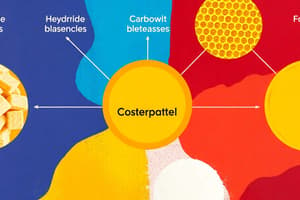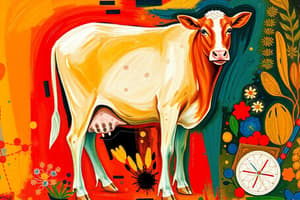Podcast
Questions and Answers
What is the primary function of carbohydrates in animal feed?
What is the primary function of carbohydrates in animal feed?
Source of energy
What percentage of plant dry matter is made up of carbohydrates?
What percentage of plant dry matter is made up of carbohydrates?
Approximately 75%
What is the difference between soluble and insoluble carbohydrates?
What is the difference between soluble and insoluble carbohydrates?
Soluble carbohydrates are broken down by GIT enzymes, while insoluble carbohydrates are resistant to GIT enzymes.
What is lignin, and what effect does it have on feed digestion?
What is lignin, and what effect does it have on feed digestion?
What is the main source of energy in animal diets?
What is the main source of energy in animal diets?
What is the function of lipase in fat digestion?
What is the function of lipase in fat digestion?
What are the two types of amino acids found in proteins?
What are the two types of amino acids found in proteins?
What is digestible energy (DE) in ruminant nutrition?
What is digestible energy (DE) in ruminant nutrition?
What is metabolizable energy (ME) in ruminant nutrition?
What is metabolizable energy (ME) in ruminant nutrition?
What is net energy (NE) in ruminant nutrition?
What is net energy (NE) in ruminant nutrition?
Flashcards are hidden until you start studying
Study Notes
Carbohydrates (CHO)
- Function as a source of energy for animals
- Composed of Carbon, Hydrogen, and Oxygen
- Make up approximately 75% of plant dry matter
- Predominantly found in concentrates
- Classified into two categories: soluble (non-structural) and insoluble (structural)
- Soluble CHO broken down by GIT enzymes (e.g., glucose, fructose)
- Insoluble CHO resistant to GIT enzymes (e.g., cellulose, hemicellulose)
- Lignin is completely indigestible and reduces digestibility of other components
Types of Carbohydrates
- Monosaccharides: simple sugars
- Disaccharides: two linked monosaccharides
- Trisaccharides: three linked monosaccharides
- Polysaccharides: many linked monosaccharides (e.g., starch)
Energy
- Derived mainly from carbohydrates and fats
- Essential for metabolic processes and growth
Fat and Energy in the Diet
- Triglycerides composed of glycerol and three fatty acids
- Functions: energy source, essential fatty acids, vitamin absorption, cell membrane structure
- Digestion: lipase breaks down fats in the small intestine; bile aids digestion
Protein
- Composed of amino acids
- Classified into essential and non-essential amino acids
- Functions: growth, repair, metabolic processes, pH balance
Metabolism and Measurement of Energy in Ruminants
- Digestible Energy (DE): proportion of feed energy not in feces
- Metabolizable Energy (ME): energy not in urine and gases
- Net Energy (NE): energy lost as heat during metabolism (Heat Increment of Feeding)
- Understanding these components helps optimize animal diets for growth, health, and productivity
Studying That Suits You
Use AI to generate personalized quizzes and flashcards to suit your learning preferences.




